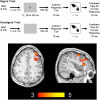CNTRICS final biomarker selection: Control of attention
- PMID: 21765166
- PMCID: PMC3245597
- DOI: 10.1093/schbul/sbr065
CNTRICS final biomarker selection: Control of attention
Abstract
Attention is widely believed to be dysfunctional in schizophrenia. The Cognitive Neuroscience Treatment Research to Improve Cognition in Schizophrenia (CNTRICS) group previously concluded that the processes involved in the top-down control of attention are particularly impaired in schizophrenia and should be the focus of future research. These processes determine which sources of input should be attended, linking goal representations in prefrontal cortex with more posterior regions that implement the actual selection of attended information. A more recent meeting of the CNTRICS group assessed several paradigms that might be useful for identifying biomarkers of attentional control and that could be used for treatment development and assessment. Two types of paradigms were identified as being particularly promising. In one approach, neural activity is measured (using electroencephalography or functional magnetic resonance imaging) during the period between an attention-directing cue and a target. In a second approach, neural activity is measured under low- and high-distraction conditions. These approaches make it possible to identify the goal representations that guide attention and the interactions between these goal representations and the implementation of selection. Although more basic science research with healthy volunteers and preclinical research with schizophrenia patients is needed before these paradigms will be ready to provide clinically useful biomarkers, they hold substantial promise for aiding in the development and assessment of new treatments.
Figures




References
-
- Luck SJ, Vecera SP. Attention. In: Yantis S, editor. Stevens' Handbook of Experimental Psychology: Vol. 1: Sensation and Perception. 3rd ed. New York, NY: Wiley; 2002. pp. 235–286.
-
- Posner MI, DiGirolamo GJ. Attention in cognitive neuroscience: an overview. In: Gazzaniga MS, editor. The New Cognitive Neurosciences. Vol 2. Cambridge, MA: MIT Press; 2000. pp. 623–632.
-
- Desimone R, Duncan J. Neural mechanisms of selective visual attention. Annu Rev Neurosci. 1995;18:193–222. - PubMed
-
- Gold JM, Fuller RL, Robinson B, McMahon RP, Braun EL, Luck SJ. Intact attentional control of working memory encoding in schizophrenia. J Abnorm Psychol. 2006;115:658–673. - PubMed
Publication types
MeSH terms
Substances
Grants and funding
LinkOut - more resources
Full Text Sources
Medical

